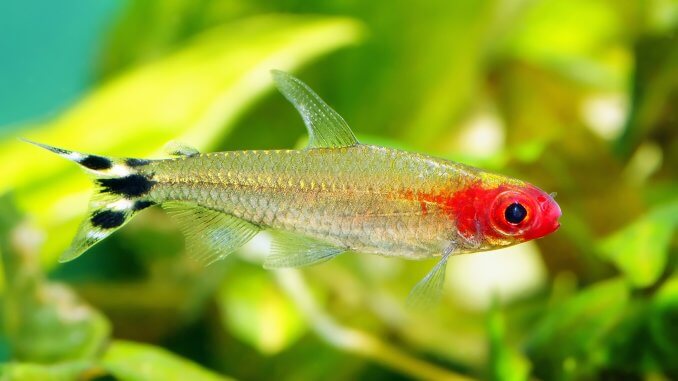
There are lots of shoaling species available for your aquarium, and it can be difficult to pick one. Even if you’ve narrowed it down to the tetra family, each member has a unique appearance to tempt you.
Rummy nose tetras display a variety of different colors and patterns across their body. This unusual mix of styles makes them stand out in your tank as one of the most attractive fish.
Keeping a shoal will intensify these colors and patterns as they move around in unison. The more you have, the better the effect.
They’re easy to feed and generally simple to care for, you just need to monitor the conditions in your tank closely. A little experience is needed to make sure they stay healthy.
This article discusses everything you need to know about looking after rummy nose tetras, from their ideal tank setups, to how to breed them and much more…
TABLE OF CONTENTS
Rummy Nose Tetra Overview
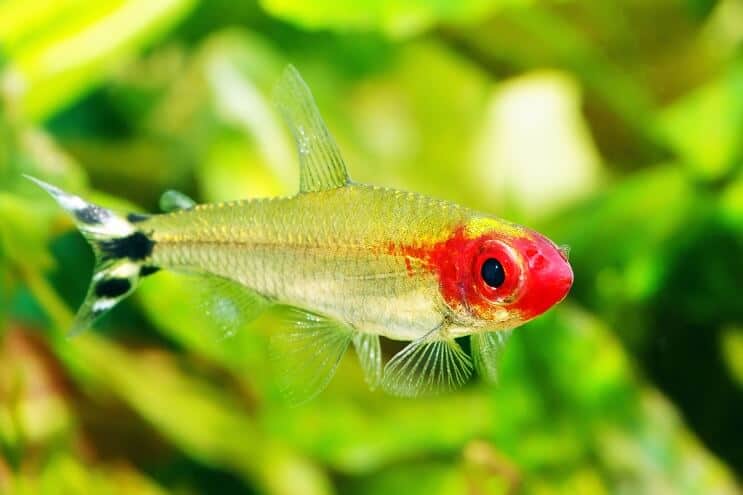
| Category | Rating |
| Care Level: | Moderate |
| Temperament: | Peaceful |
| Color Form: | Silver body, red nose, black/white striped caudal fin |
| Lifespan: | 6-8 years |
| Size: | 2-2.5 inches |
| Diet: | Omnivore |
| Family: | Characidae |
| Minimum Tank Size: | 20 gallons |
| Tank Set-Up: | Planted freshwater tank with open swimming space |
| Compatibility: | Peaceful community aquariums |
The rummy nose tetra is a freshwater fish from the Characidae family.
There are three very similar species which are all known as rummy nose tetras:
- Hemigrammus rhodostomus (The True Rummy Nose Tetra)
- Hemigrammus bleheri (Also known as The Brilliant Rummy Nose Tetra or The Common Rummy Nose Tetra)
- Petitella georgiae (The False Rummy Nose Tetra)
All three species are native to South America where they live in the Amazon River (each species occupies a different region).
Shoaling fish are often popular with beginners, but these aren’t the easiest examples to care for. They can be quite sensitive to water parameter changes so you need to be vigilant; they don’t handle mistakes well.
A group works well in a community tank. As peaceful fish, they get on well with lots of other species, but they won’t do well with boisterous fish that cause them stress.
Since rummy nose tetras are so popular, they are sold cheaply in most aquarium stores. Each fish you buy will cost no more than $4, but you can usually get them cheaper if you buy a few at a time.
They can live for 6-8 years if kept in a healthy environment.
Typical Behavior
These fish shoal, so they will spend most of their time grouped together. This creates some impressive displays. The colors are more striking and their behaviors are more impressive when swimming together.
The larger the shoal, the better these displays. Don’t be tempted to overstock your tank though; rummy nose tetras enjoy having plenty of swimming space.
Usually, they swim around the middle levels of the water, however, they might stray up or down in order to feed.
You may see them hiding among plants if they get stressed by bright lights or pestering fish.
Appearance
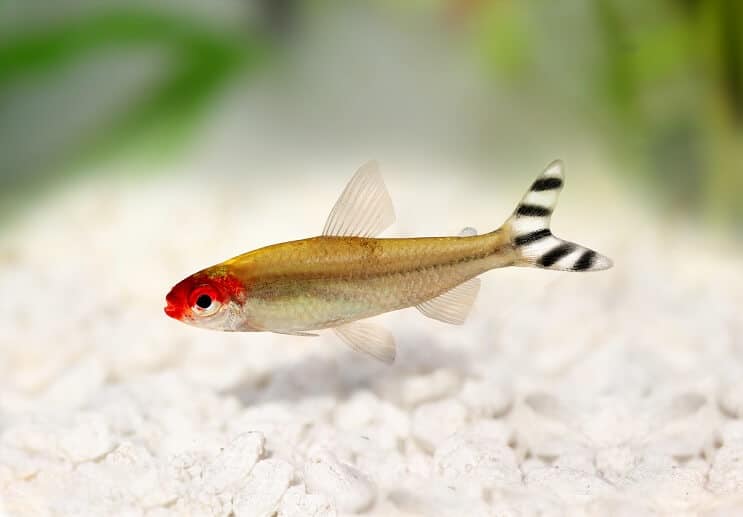
These tetras are popular because of their interesting colors and patterns across their body.
Most of their body is plain silver. Their head is a deep red which gives them their name.
The caudal fin stands out just as much as the head. It has a zebra-like design of black and white horizontal stripes.
Their body is a torpedo shape with short, clear fins (except the caudal fin). Once fully grown they should reach 2.5 inches long.
There are a few differences between the three species. The most notable is that the common rummy nose tetra is usually a little shorter than the other two, at about 2 inches. Other differences are minor and very hard to spot (even by those who have looked after them for years).
Sexing individuals is just as difficult. There’s no reliable way to distinguish them by eye, but some people suggest that females have a slightly larger body.
Habitat and Tank Conditions
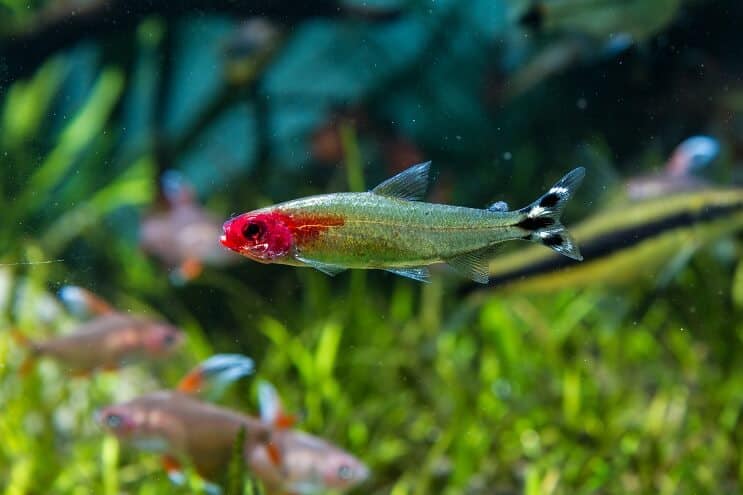
All three species are naturally found in the Amazon River in South America. Even though they live in different regions, they are all used to similar conditions.
The riverbed has a soft, sandy substrate. Planted areas are scattered around which acts as food and shelter; rocks and caves are common too.
The water here is warm and slightly acidic. There is plenty of access to light and the river’s flow keeps the water moving.
The true rummy nose tetra is found closer to the Atlantic coastline. The common rummy nose is found further inland and has a narrow range (the middle portion of Rio Negro in Brazil). Finally, the false rummy nose tetra is also found further inland but has a broader range (living in Brazil and Peru).
Tank Setup
The setup is simple and not too difficult to maintain.
Starting at the bottom of the tank, you will want a fine-grained substrate. This will most closely resemble these species’ natural habitat. You can use gravel if you prefer since rummy nose tetras don’t spend much time in the lower levels of the tank.
Pick some plants that will grow into the middle levels of the water. These are the preferred shelter of tetras; they may want to get away from other fish or bright lights when stressed.
Decorations aren’t too important, but you can add some if you want. Just make sure that you leave plenty of space for swimming.
A heater is needed to keep the water warm. The temperature should be in the range of 75-84°F to match the tropical waters of the Amazon. pH needs to be controlled too, keep it between 6.2-7.0. Hardness should be 2-10 KH.
You don’t need an air/water pump as the filter outlet will keep the water moving, but you can add them if you’d like. Standard aquarium lighting is suitable; they’ll take cover in the plants when they need shelter from the lights.
An external filter is advisable since rummy nose tetras can be sensitive to ammonia/nitrates in the water and external filters tend to be more effective.
What Size Aquarium Do They Need?
Rummy nose tetras need at least a 20 gallon tank. Although they are small, they enjoy having plenty of space to shoal and swim.
How Many Can Be Kept Per Gallon?
One fish per two gallons will mean that there’s lots of space to avoid overstocking. With a 20 gallon tank you can keep 10 tetras.
Tank Mates
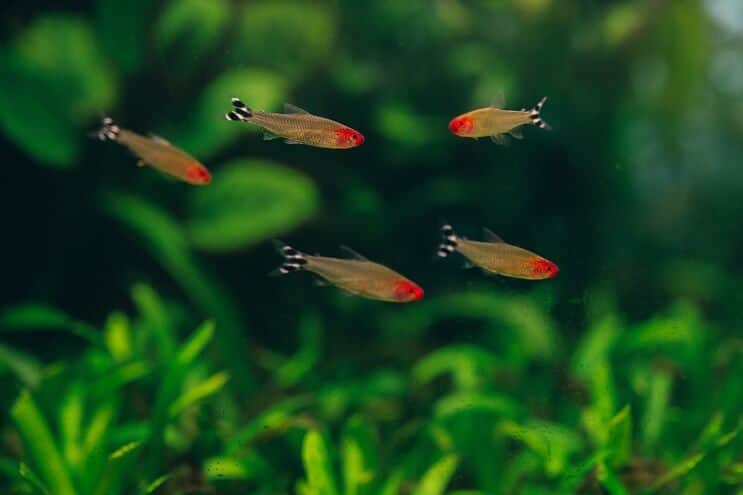
They are peaceful fish that are great for community aquariums. They won’t offend any of their tank mates, but they can become easily stressed by more boisterous fish.
You should avoid large fish with mouths big enough to eat your rummy nose tetras. Stay away from species with an aggressive reputation too. This rules out a lot of cichlids, but not all of them (such as angelfish).
Larger fish can be quite messy too. This will make it harder to maintain healthy water conditions, which is crucial for rummy nose tetras.
You can keep them with most small fish, such as: danios, tetras, mollies, Corydoras catfish, yo-yo loaches, hatchetfish, harlequin rasbora, cherry barbs, and dwarf gourami.
Both snails and shrimp are good options to keep with your tetras but watch out for your plants as snails may snack on them.
Keeping Them Together
Rummy nose tetras should be kept in groups. They are used to living with lots of their own kind, so buy at least 6.
When kept on their own, they can get stressed and become easy targets for boisterous fish.
Diet
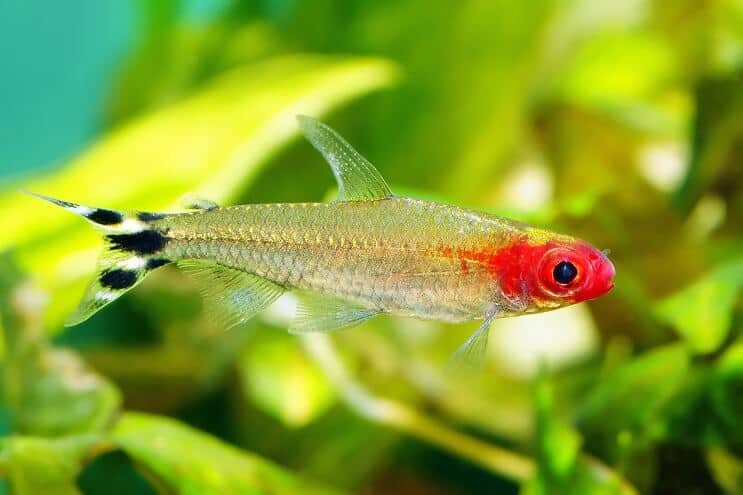
Rummy nose tetras are omnivores. So in the wild, they would eat small bits of plant debris, small insects, larvae, or eggs. Generally, anything that would fit into their mouths.
There are lots of foods available from stores to provide them with a similar diet at home. Flake and pellet foods are some of the simplest options; these are designed to contain all the nutrients they need.
Use flakes or pellets as the staple of their diet, and then give them additional treats once or twice a week.
Both live and frozen foods are good ways to provide some protein, and they can be used to give your tetras some variety. Daphnia and bloodworms are good choices.
Any spare green vegetables can also be added into their tank. Make sure to chop them into small pieces.
Though these fish can eat plants, they’re unlikely to cause much damage as long as you’re feeding them well.
Aim to feed them twice a day. Breaking up their feeding like this gives them a chance to digest their food. Only give them an amount that they can finish in two minutes, remove any excess food after this so it doesn’t decay in the tank.
Care
Providing your tank is kept in the conditions we mentioned earlier, your tetras will be healthy.
But, even if your tank stays clean, sometimes the disease is unavoidable, so you might see your fish getting ill. Dropsy and ich are a couple of common diseases.
An easy way to spot if something is wrong is by looking at their red noses, they often get much paler in bad water conditions.
Dropsy is a fluid build-up causing the body to swell. Fish with Ich will develop white spots all over their body.
It’s important to know how to clean a tank properly because poor water quality helps the disease spread through the water. Give your tank a clean and see if there is any improvement.
There are treatments that you can buy from stores if your fish aren’t showing any signs of recovery.
Poor nutrition can also contribute to these problems. If your tetras aren’t getting everything they need from their diet they will be more susceptible to disease. Switching up their diet is a great way to ensure they are getting all the nutrients they need.
A healthy rummy nose tetra should live for 6-8 years.
Breeding
The first problem you will encounter when breeding your rummy nose tetra is making sure you have a good mix of males and females. Since they are so difficult to sex, this can often be trial and error. The best option is to get their sex confirmed by a specialist breeder when you buy them.
To encourage breeding, the conditions in the tank need to be perfect. Warm the tank up to around 84°F, this should trigger spawning. Strong filtration is important; these fish are sensitive and won’t spawn in polluted water.
The breeding process takes place around plants, so make sure you’ve added plenty to the tank. The female will swim over to a leaf, rollover, and let the male fertilize the eggs.
She will release a few large eggs. Once this has happened, separate the adults from the eggs so that they’re not eaten.
The fry will hatch after 24 hours but won’t start swimming around for 6 days. They will be slightly larger than fry of similar age from other species. Feed them specialized fry foods until they are large enough to accept the same diet as adults. Once the fry is nearly the same size as the adults they can be kept together again.
Are Rummy Nose Tetras Suitable For Your Aquarium?
As peaceful fish, they pair well with other peaceful species, and their setup requirements are similar to lots of other fish.
There are just a few things to bear in mind.
Keep them away from large or aggressive fish. They can get stressed easily and their health will deteriorate as a result.
The water should be kept clean since this species is particularly sensitive to pollutants in the water. They will thrive in a clean tank and you will get a bright display of colors as a result.
A shoal of these fish adds life to your tank. After watching them for just a little while, you’ll realize you made the right choice.
Are rummy nose tetras one of your favorite fish? Let us know why in the comments below…

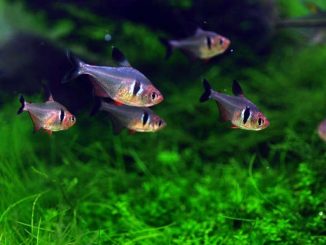
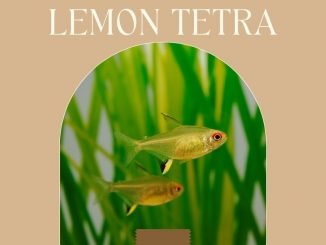
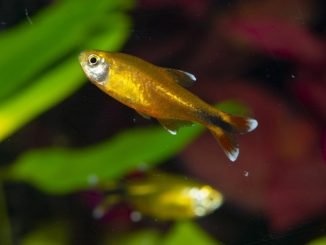
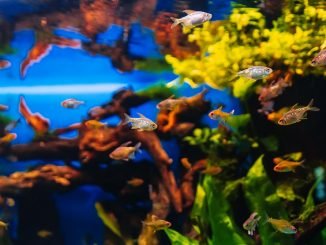
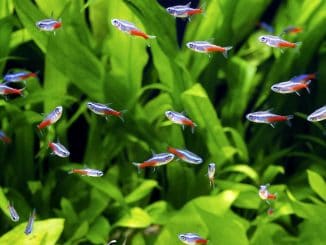
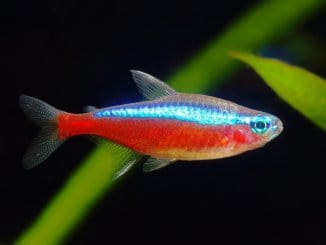
Nice informative article. I have many favorite fish and these are one. The bright colors and tight formation of the school is fascinating to watch. Every NASCAR fan should own these because they remind me of the checkered flag.